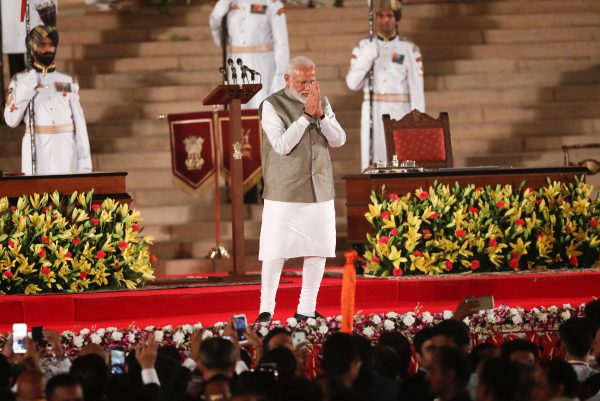Let’s characterise his options as Three Shades of Saffron (the colour of Modi’s party and the robes of Hindu holymen): Saffron Full-on, Saffron Regular and Saffron Lite. Aspects of each are entwined and not mutually exclusive, but thinking of them in three categories provides a framework to examine possibilities.
In this scenario, the BJP would create a Hindu majoritarian state — a sort of Hindu Pakistan. Adherence to a code of high-caste Hindu behaviour, as interpreted by the ruling party and its associates, would be the only acceptable conduct. This path would emphasise the politics of culture. A common civil code would be endorsed, eliminating ambiguities in Indian law that have allowed Muslims to use Islamic law in personal matters.
The ‘special status’ of Jammu and Kashmir, India’s only Muslim-majority state, disputed with Pakistan since 1947, would be abolished. A great temple for Lord Ram would be built — ‘reinstated’, its advocates would say — in north India where a mob demolished a mosque in 1992. The constitution would be changed to eliminate ‘secular’ elements and introduce Hindu ones — for example, a prohibition on cow slaughter.
These measures would please ideologues in the BJP and the Rashtriya Swayamsevak Sangh (RSS), the militant organisation that gave birth to the BJP. Such measures would also please many — not necessarily all — of the 37 per cent of citizens who voted for BJP candidates in the recent elections. There is a spirit of aggressive ‘Hindu’ identity abroad. As one example Sadhvi Pragya Thakur, a vitriolic Hindu religious figure who has praised the assassin of Mahatma Gandhi as a ‘patriot’ (deshbhakt), won the seat of Bhopal — once the capital of a Muslim princely state — by 360,000 votes over a former popular chief minister.
If Modi and his party followed the Full-on path, they would still have to face at least two urgent and unavoidable problems.
The most pressing and difficult is the rural crisis. Though India urbanises steadily, more than 60 per cent of Indians still live in the countryside despite only 15 per cent of Indian GDP coming from agriculture. A cobweb of rules and policies spun over many years makes it increasingly difficult for smallholders to make a decent income from their land. Farmer protests and suicides in recent years indicate this festering problem.
Partial solutions lie in diversifying production into more valuable crops, but this will require vastly improved logistics — the ability to get perishable produce reliably to market and ensure fair prices to growers. In the recent elections, rural constituencies embraced the BJP just as avidly as urban voters. That result may cause advocates of the ‘Full-on Saffron’ persuasion to subordinate agrarian challenges to the cultural offensive, confident that ‘rural India will wait’.
The second inescapable problem is financial. Many of India’s debt-laden public-sector banks have balance sheets gravely ill with bad loans re-financed because borrowers are politically well-connected entrepreneurs. At some point, bad-loan chickens must come home to roost. And though the national taxation system promises to improve as the new GST overcomes its hiccups and complications, the tax system is far from snaring the revenue it should from those who can afford to pay.
A second path for the new government — ‘Saffron Regular’ — would be to continue on the course of the past five years. Potentially explosive cultural changes would be left as tantalising aspirations for the faithful, while a relentless cultural agenda and hugely publicised poverty-alleviation programs would continue.
The cultural dimension involves rewriting school curriculums to celebrate the BJP/RSS version of Indian history. This is accompanied by appointments of true-believers to every institution government can influence — from college principals to the heads of judicial, educational, financial, media and administrative organisations.
The carefully crafted government initiatives, and the skilful public relations that go with them, will continue. These include the Clean India (Swachh Bharat) campaign and its toilet-building component, a transfer program of Rs 2000 (US$29) to the bank accounts of poor agriculturalists, and provision of cooking gas to poor households. Add to these a major drive to electrify villages across north India, and the BJP’s media machine will have plenty to rhapsodise about.
These tangible, daily-used benefits follow a model Modi and his chief of staff Amit Shah, the BJP president, developed in Gujarat when Modi was chief minister. The delivery of reliable electricity and decent roads pleased voters and helped to make Modi’s reputation.
‘Saffron Regular’ allows BJP governments to continue to tut-tut disapprovingly when attacks occur on those who don’t subscribe to their view of how a ‘Hindu nation’ should behave. Such people include ‘secular liberals’, assertive women, lower castes who don’t conform and non-Hindus — especially Muslims, but with Christians on notice. Victims don’t get much support and perpetrators don’t have much to fear.
Lastly, in a ‘Saffron Lite’ scenario, Modi would cut back the cultural agenda. The government would pursue vikas (development) — not emphasised in the recent campaign — as its trumpeted goal. A strong, rules-based government would reform taxation, re-channel expenditure and build the infrastructure to modernise agriculture and sustain rapidly growing cities.
The BJP (the political party) would differentiate itself more strongly from the RSS (the militant movement) and transform itself into something like the Christian Democratic Union of post-war Germany. ‘Liberal secularists’, would find space in state institutions. And the Indian miracle — a vast single state composed of many languages, regions, castes and religions — would become an example in a xenophobic world. Modi would become more like Konrad Adenauer, maker of Europe’s most admired country, rather than any of the other characters from the cast-list of German history.
But don’t bet the farm on this one.
Professor Robin Jeffrey is a Visiting Research Professor at the Institute of South Asian Studies, the National University of Singapore.

